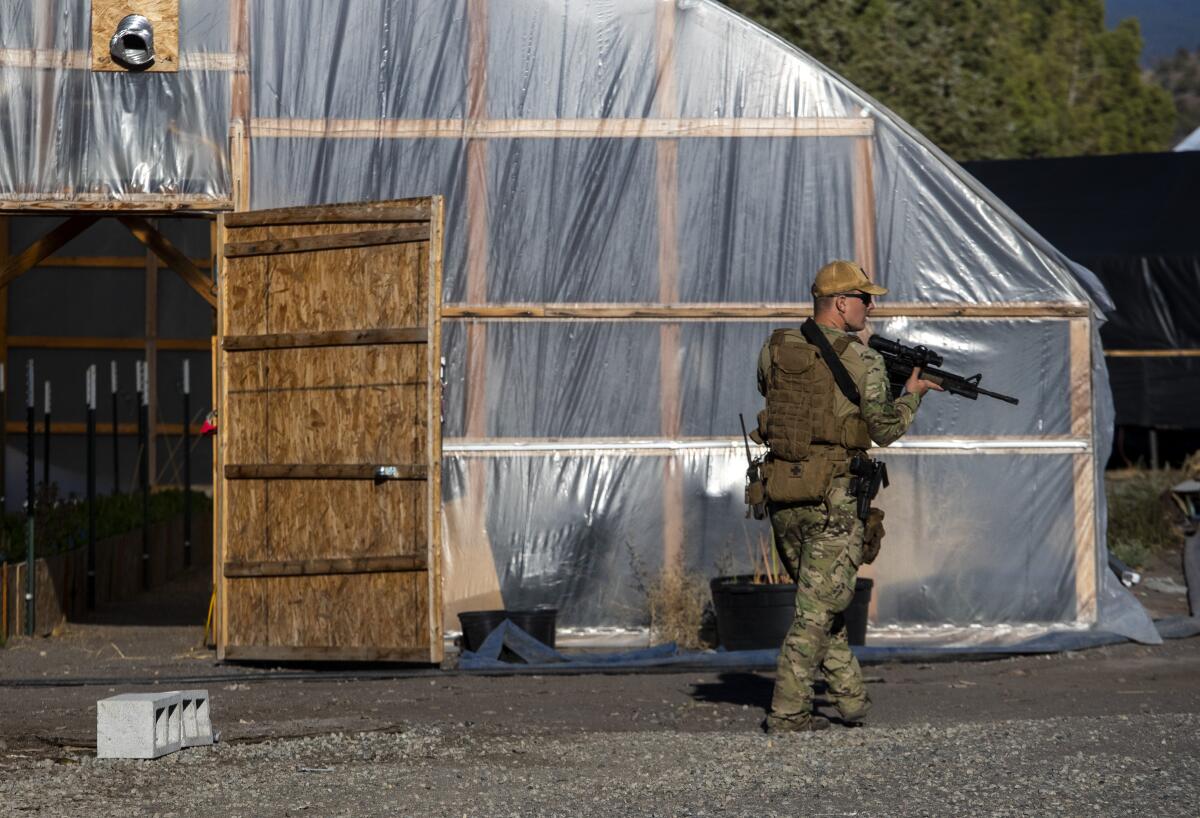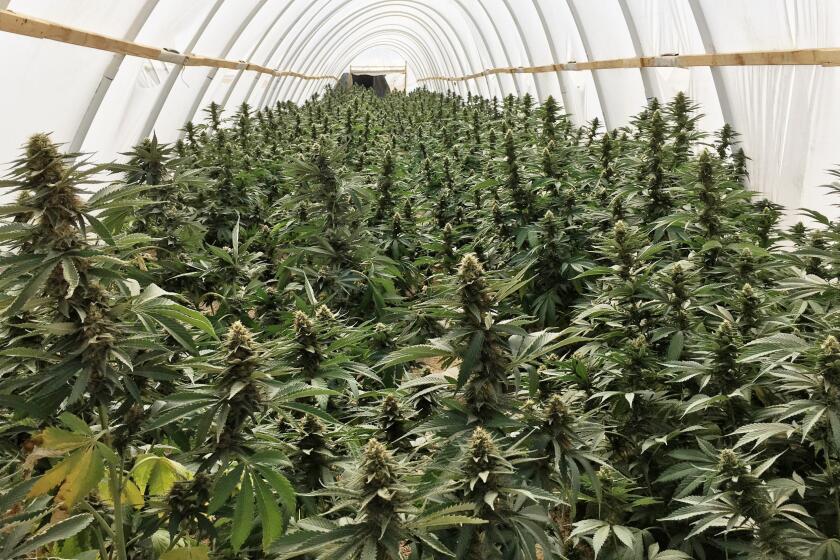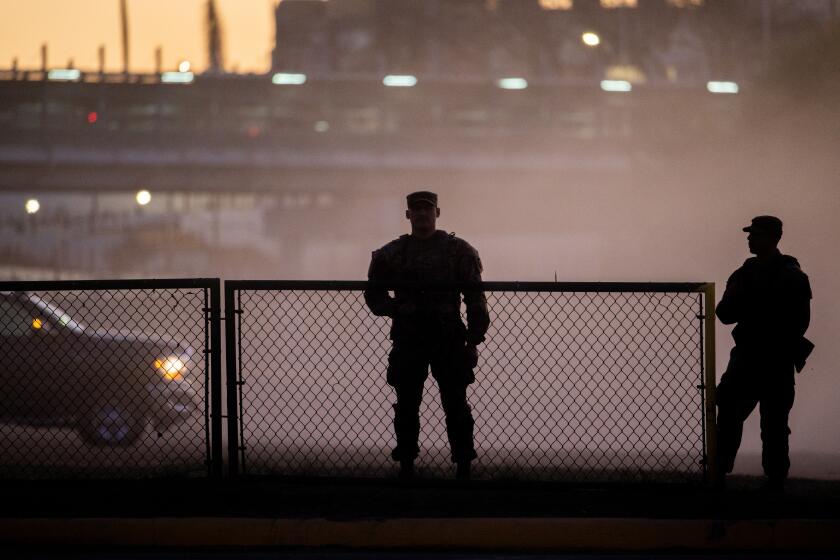Column: Marijuana isn’t really fueling the cartels. It’s U.S. laws that drive the violence

- Share via
Police found six people shot to death last week near U.S. Highway 395 — roughly 50 miles outside of Los Angeles. The gruesome scene was another example of the kind of violence that shadows illegal marijuana operations in California and beyond.
In 2020, seven people were killed in a rural community in Riverside County. In 2021, a father and son were not only shot but also dismembered and burned in the Emerald Triangle in Northern California. All the deaths were somehow connected to illegal pot, some involving a cartel, explaining why many of the murders mirror the type of message-sending bloodshed that defined the country’s Prohibition era nearly a century ago.
Opinion Columnist
LZ Granderson
LZ Granderson writes about culture, politics, sports and navigating life in America.
“All I do is to supply a public demand,” Al Capone once said. “Somebody had to throw some liquor on that thirst. Why not me?”
The licensing, taxing and regulatory system imposed on those who hope to sell cannabis legally are crippling and put them at a huge disadvantage.
To his point, Americans kept drinking despite ratification of the 18th Amendment in 1919, providing organized-crime bosses like Capone a lucrative underground business that was violently protected. Similarly, society has never waited for Congress to legitimize usage of marijuana. The 1969 stoner film “Easy Rider” may have been characterized as “counterculture,” given only 12% of Americans thought pot should be legal at the time, but in hindsight that picture of recreational drug use in America wasn’t “counter” as much as uncomfortably accurate.
House Republicans are ready to kill any measure that might improve security at the southern border, because sustaining the danger could help Trump in November.
Some of the biggest names in music, including the Beatles, were making songs about pot back when President Nixon began his misguided war on drugs. Today we have celebrities with careers built on a stoner persona, 70% of Americans want it legalized, and roughly half the country’s states already allow recreational marijuana.
And yet somehow marijuana prohibition is still the law of the land, as the Drug Enforcement Administration considers it a Schedule I drug like heroin. Because of that, this multi-billion-dollar industry is trapped between two worlds, and organized crime is once again thriving in that murky space.
Greg Abbott’s policies are killing refugees trying to flee across the border. Many voters oppose his methods but appreciate that he takes the crisis seriously.
This black market continues despite relaxed state enforcement in part because the changes create a new problem: overtaxation. The sticker shock from getting pot legally can feel like paying an exorbitant fee to stay out of jail. When juxtaposed against what it costs to buy from the local dealer, shopping at a dispensary feels less like commerce and more like extortion.
There are other practical concerns associated with an industry that is both legal and illegal.
For example, what do would-be entrepreneurs in the cannabis industry put on their loan applications at federally regulated banks? In 2022, a 27-year-old woman died from an asthma attack caused by cannabis dust while working at a marijuana facility in Massachusetts. Her death was the first of its kind to be reported by the Centers for Disease Control and Prevention since legalization began in 2012. To what extent can a federal agency such as the Occupational Safety and Health Administration officially intervene in the work environment of an industry that isn’t legal federally?
This week Sen. Alex Padilla (D-Calif.) joined other Senate Democrats in a letter urging the Biden administration to lift the federal marijuana ban. Currently the White House is considering downgrading weed from Schedule I, which is where Nixon placed it without research, to Schedule III. However, that wouldn’t totally solve the problem.
“Marijuana’s placement in the [Controlled Substances Act] has had a devastating impact on our communities and is increasingly out of step with state law and public opinion,” the letter read. “Criminal penalties for recreational marijuana use, and for medical use of marijuana products that lack federal approval, would still exist, disproportionately penalizing Black and Brown communities.”
Which is exactly what Nixon intended when he started his bigoted war on drugs in the first place.
This wink-wink between Washington and the states also leaves the more than 400,000 people employed by the cannabis industry across the country vulnerable to abuse. It’s a huge swath of people, more in California (83,000) than in any other state. Florida ranks fourth.
You read that right: The state that Gov. Ron DeSantis described as “where woke goes to die” is also the state where the smoke lives on — a political dynamic that epitomizes just how ridiculous it is that we’re still debating this along party lines.
Biden should listen to the senators and the 70% of Americans and remove the federal marijuana ban altogether.
Old puritanical fantasies about who we are as a society are a harmful relic, as are the punitive tax structures surrounding cannabis. Not only that, marijuana prohibition continues to create an environment in which more and more desert communities are encountering cartel activity, and local authorities are finding dead bodies on dirt roads.
The failed Prohibition era of the 1920s revealed the pitfalls of trying to legislate morality. And here we are again. Surely we can all recognize that the cartel is killing far more people than smoking cannabis ever could.
Lift the ban. Stop the overtaxation. Save lives.
More to Read
A cure for the common opinion
Get thought-provoking perspectives with our weekly newsletter.
You may occasionally receive promotional content from the Los Angeles Times.















